Table of Contents
I’ve always loved how Indonesian satay transforms the simplest ingredients into something special. A few skewers, a brush of marinade, a hot grill, and suddenly you’ve got smoky, sweet, savoury perfection on a stick. When I first started experimenting with Indonesian satay recipes, I quickly realised how varied and rich they are. Each region does it differently, with its own twist of spice, sauce, and method.
This collection of Indonesian Satay recipes brings together ten of my favourite versions, all tested and cooked right in my kitchen. From the classic sate ayam to the fragrant sate lilit and even a plant-based tofu and tempeh satay, each recipe captures a piece of Indonesia’s food heritage through the comforting act of grilling. The beauty of these dishes is that you can mix and match—choose one or make several for a full spread.
Here you’ll find everything from creamy peanut sauces to tamarind glazes, and a few secrets on how to get that perfect caramelised edge. Every recipe links to a full step-by-step version, with ingredients, pairing ideas, and tips for success.
Essential Equipment for Making Indonesian Satay at Home
Good satay begins long before the grill is lit. The right tools help you achieve that perfect balance of smoke, sear, and tenderness that defines Indonesian BBQ. You don’t need a professional setup, but a few reliable pieces of equipment will make every recipe smoother and more enjoyable to cook. I’ve tested all ten of my Indonesian satay recipes with home kitchen tools, and these are the ones that consistently earn their place on my countertop.
Best charcoal grill for making Indonesian satay
A good charcoal grill is where the magic happens. It gives you that unmistakable smoky depth that gas or electric heat can’t quite replicate. I love using a compact, portable model with adjustable vents so I can control the temperature, this charcoal grill is my go-to for even heat and rich flavour. If you prefer indoor cooking, a heavy cast-iron grill pan delivers equally satisfying results. It heats evenly, holds temperature beautifully, and adds perfect sear lines, you can find my favourite cast-iron grill pan here.
Essential: Best skewers for Indonesian satay
When it comes to skewers, I like to mix materials depending on the recipe. Bamboo skewers add a rustic touch but must be soaked in water first to prevent burning, these extra-long bamboo skewers are the ones I keep stocked at home. For sturdier cuts like beef or lamb, stainless-steel skewers are ideal. They’re reusable, easy to clean, and distribute heat evenly, this reusable metal skewer set has lasted me years.
Tools for the perfect marinade
To make marinades and spice pastes, a mortar and pestle, a must-have kitchen tool, gives the most authentic texture. Crushing lemongrass, garlic, and galangal by hand releases oils that a knife can’t. Still, a mini food processor works beautifully when time is short—this compact chopper blends marinades in seconds. I use mine for everything from peanut sauce bases to Balinese spice pastes.
Lastly, a few small tools make grilling easier and neater. A heat-resistant silicone brush helps you baste evenly, this silicone brush set is sturdy and dishwasher-safe. Long tongs protect your hands while turning skewers, and a digital meat thermometer ensures perfect doneness every time, this instant-read thermometer is the one I trust for grilling satay.
Each of these tools has earned a permanent spot in my kitchen because they make the process effortless. From a well-built grill to thoughtfully designed utensils, investing in good equipment means your sate ayam, sate kambing, and tofu satay will taste consistently brilliant—crispy on the outside, tender in the centre, and perfectly coated in sauce.
My favourite Indonesian satay recipes ever
Sate Ayam: Authentic Indonesian Chicken Satay with Peanut Sauce
Sate ayam is probably the best-known Indonesian satay, and it’s easy to see why. The chicken is marinated in coconut milk, garlic, and turmeric, then grilled until slightly charred and brushed with a velvety peanut sauce. It’s nutty, fragrant, and endlessly comforting.
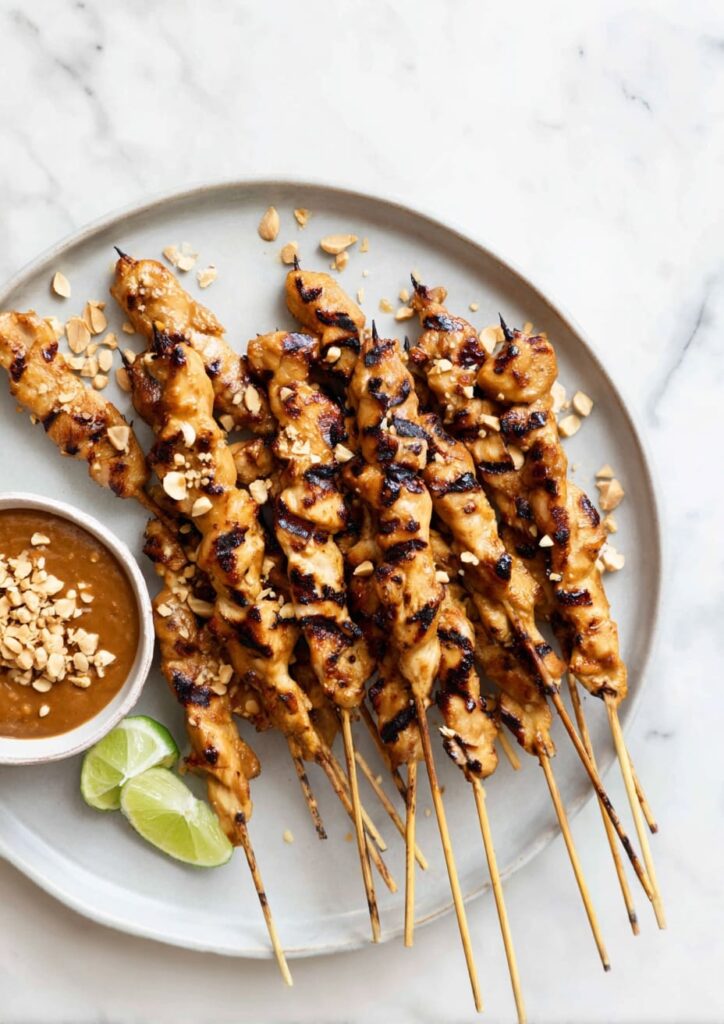
I’ve made it more times than I can count, tweaking the sauce until it’s rich without being heavy. The combination of coconut milk and tamarind gives the perfect balance of sweetness and acidity. It’s the one I always serve alongside rice cakes or cucumber slices for freshness. You can make it at home using my Sate Ayam recipe.
Sate Madura: Spiced Chicken Satay with Sweet Soy Marinade
Sate madura is darker, bolder, and slightly sweeter than sate ayam. It uses a thick soy-based marinade made with kecap manis, shallots, and palm sugar, creating a sticky glaze that caramelises on the grill. The sweetness gives it a glossy finish, and the tamarind juice adds just enough tang to balance the richness.
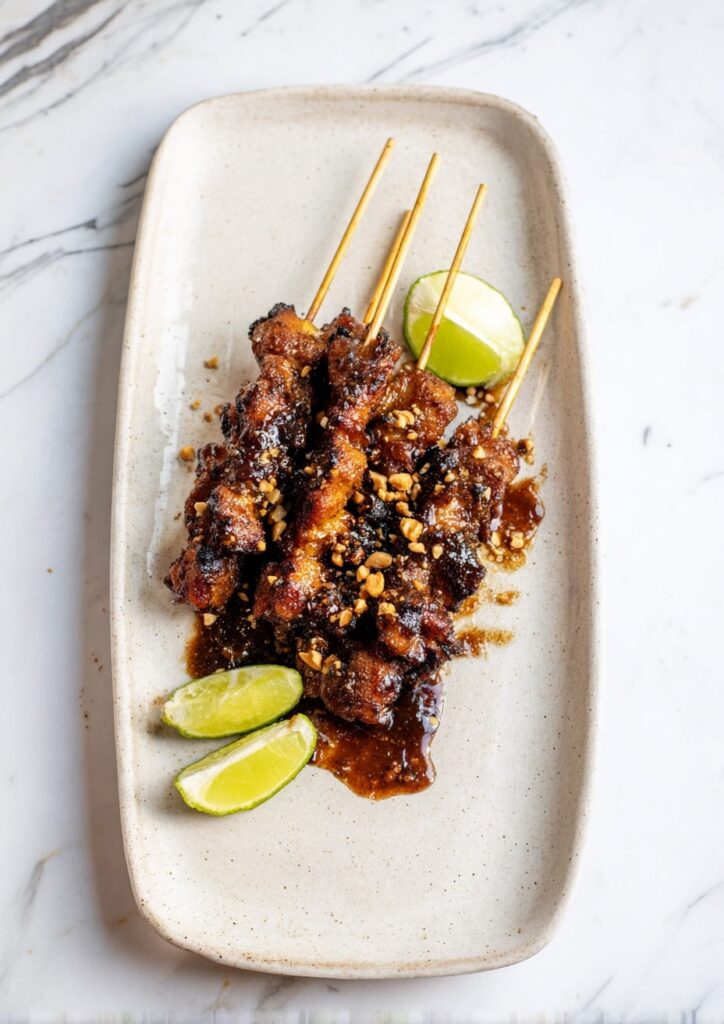
It’s wonderful with rice or lontong and a drizzle of extra soy on top. When I make it, the smell alone brings everyone into the kitchen. You can find the full instructions in my Sate Madura recipe.
Sate Padang: West Sumatran Satay with Curried Sauce
Sate padang stands out for its thick curried sauce made with turmeric, lemongrass, and galangal. Instead of peanuts, the sauce is thickened with rice flour, creating a silky gravy that clings to each skewer. It’s usually made with beef, though chicken or tofu works too.
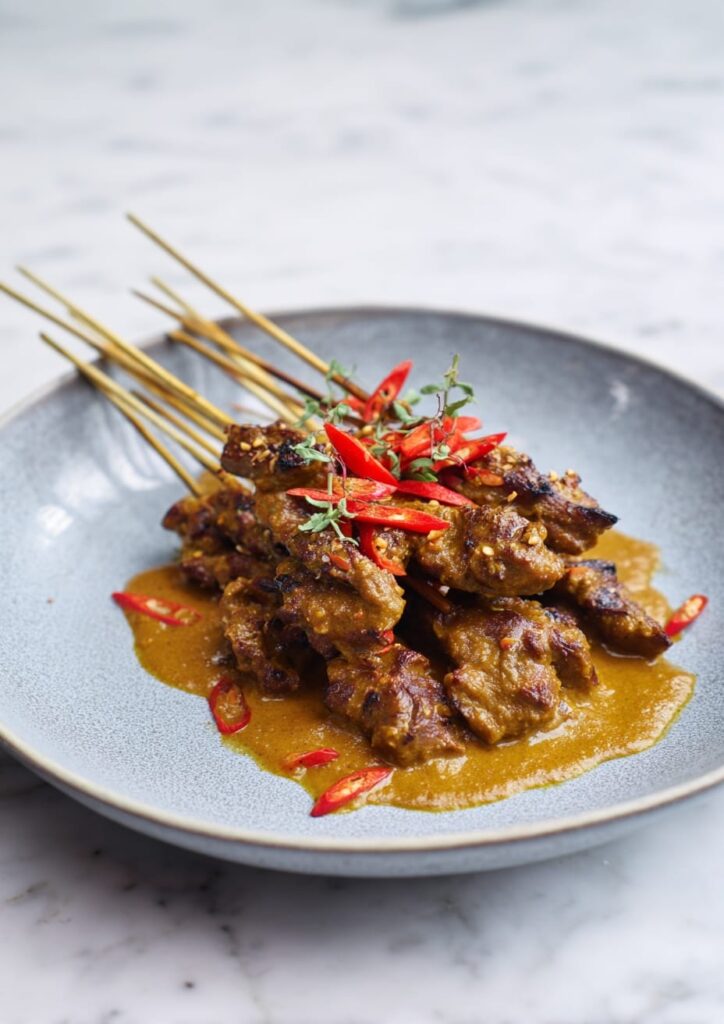
The spices bloom slowly in coconut milk until the sauce becomes golden and fragrant. It’s less sweet than other versions but incredibly satisfying. My Sate Padang recipe includes a few small tricks to get the sauce glossy and smooth.
Balinese Pork Satay with Lemongrass and Coconut Marinade
Balinese pork satay, or sate babi, is sunshine in food form. The marinade bursts with lemongrass, galangal, and coconut milk, giving a bright, fragrant flavour that’s both sweet and savoury. The pork develops a golden crust that’s slightly sticky from palm sugar, and the scent of lemongrass fills the air as it grills.
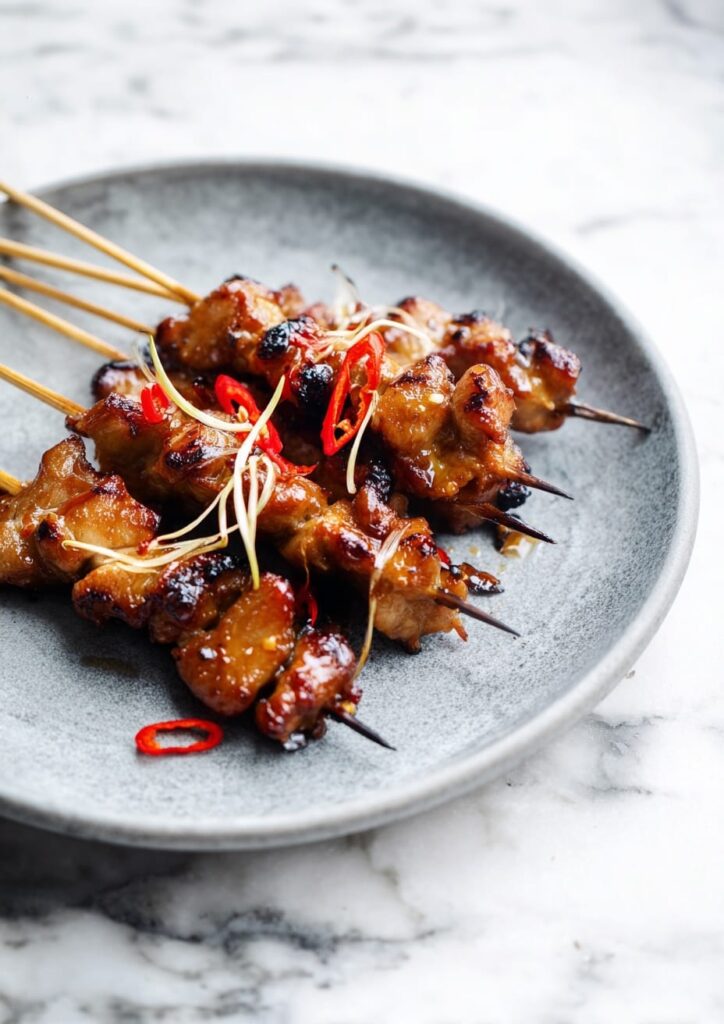
It’s one of those recipes where balance matters—lime juice and tamarind cut through the richness perfectly. My Balinese Pork Satay recipe captures those details, plus a few tips on how to keep the skewers juicy.
Sate Kambing: Indonesian Grilled Lamb Skewers with Tamarind Glaze
Sate kambing is the satay for anyone who loves bold flavours. Lamb or goat meat is marinated in a blend of garlic, coriander, cumin, and sweet soy, then brushed with a tamarind glaze as it grills. The tang of tamarind cuts through the richness, while palm sugar gives a dark, caramelised edge.
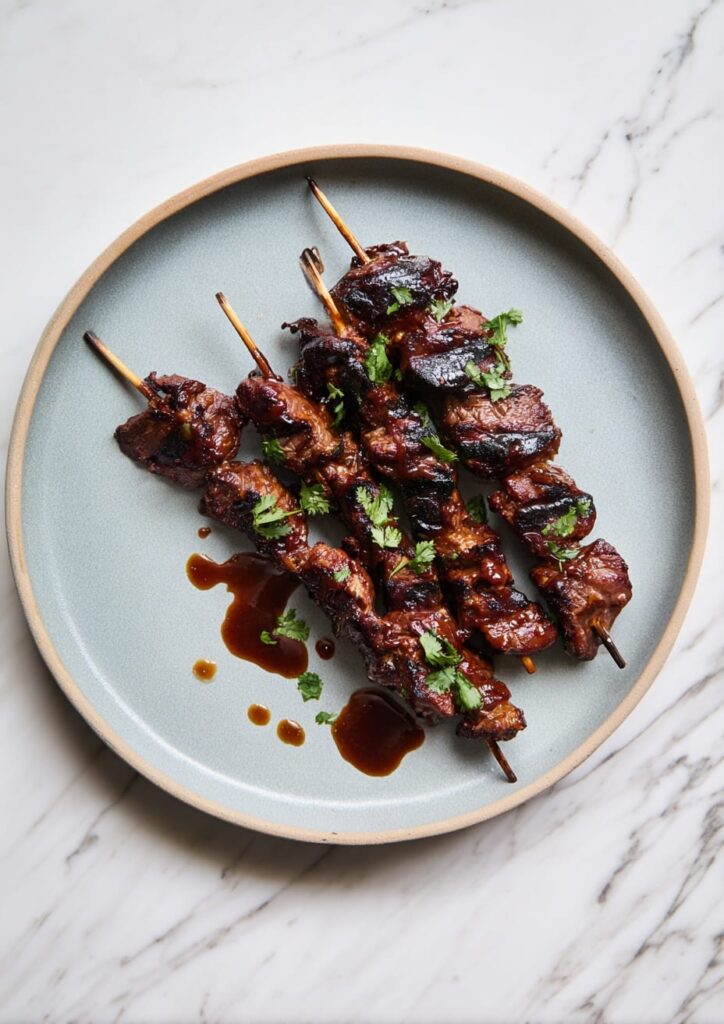
It’s slightly smoky, deeply aromatic, and utterly satisfying with a side of tomato sambal. My Sate Kambing recipe shows exactly how to get that glossy finish without burning the glaze.
Beef Satay with Kecap Manis and Coriander Marinade
This is my go-to Indonesian satay when I want something robust and comforting. The beef is marinated in kecap manis, lime juice, and coriander, then grilled quickly over high heat. The glaze caramelises into a dark, sticky coating that smells incredible the moment it hits the grill.
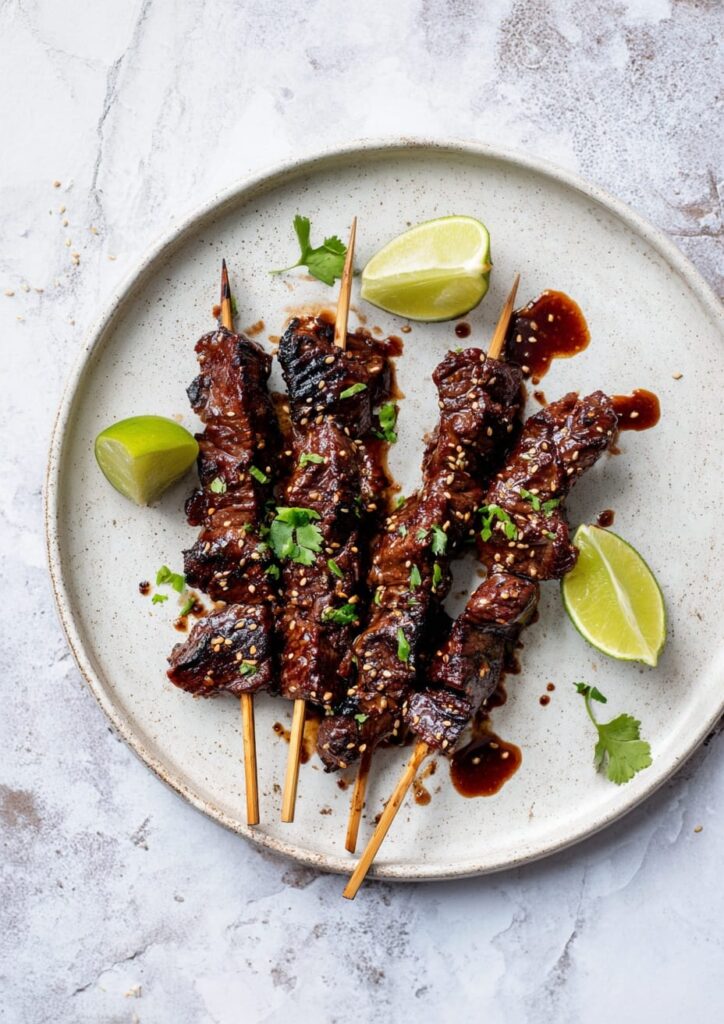
The coriander adds warmth, while the lime keeps it bright. It’s a crowd favourite on any Indonesian BBQ table and pairs beautifully with sambal kecap. My Beef Satay recipe walks through the process, including the trick to balancing caramelisation and tenderness.
Sate Lilit: Balinese Minced Fish Satay with Turmeric and Galangal
Sate lilit is delicate and aromatic, a refreshing change from meat-heavy skewers. Minced fish is blended with grated coconut, turmeric, galangal, and lemongrass, then wrapped around lemongrass stalks before grilling.
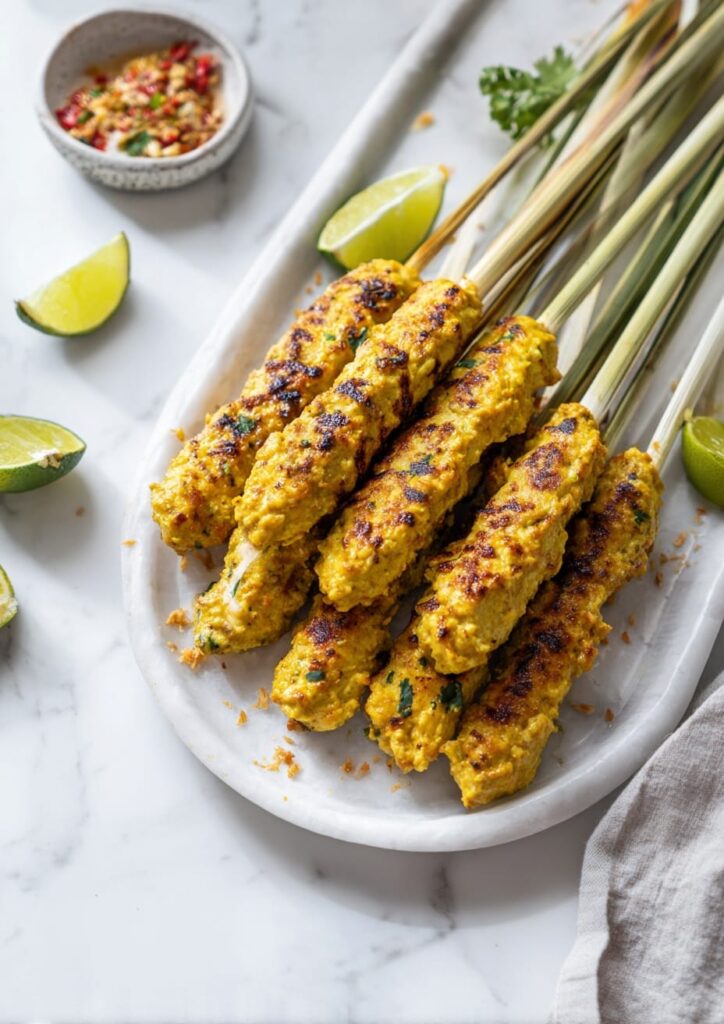
The result is soft, fragrant satay with a citrusy edge and a gentle sweetness from the coconut. It’s proof that satay doesn’t need to be heavy to be satisfying. The Sate Lilit recipe includes step-by-step tips for keeping the mixture light but cohesive.
Tofu and Tempeh Satay with Spicy Sambal Peanut Sauce
Tofu and tempeh satay is my favourite plant-based alternative. It has all the flavour of traditional satay, with none of the meat. The tempeh adds nuttiness, the tofu turns silky inside, and both soak up a punchy marinade of tamarind and sweet soy. The sambal peanut sauce brings it all together with heat and richness.

It’s one of those dishes that even meat eaters go back for seconds of. You can make it easily following my Tofu and Tempeh Satay recipe.
Indonesian Satay BBQ Platter: Mixed Meats and Homemade Sauces
If you can’t decide which Indonesian satay to make, go for them all. This platter is a relaxed mix of chicken, beef, pork, tofu, and tempeh, each with its own sauce—peanut, soy, and curry. It’s colourful, communal, and endlessly adaptable. The secret is grilling everything in stages so nothing overcooks.
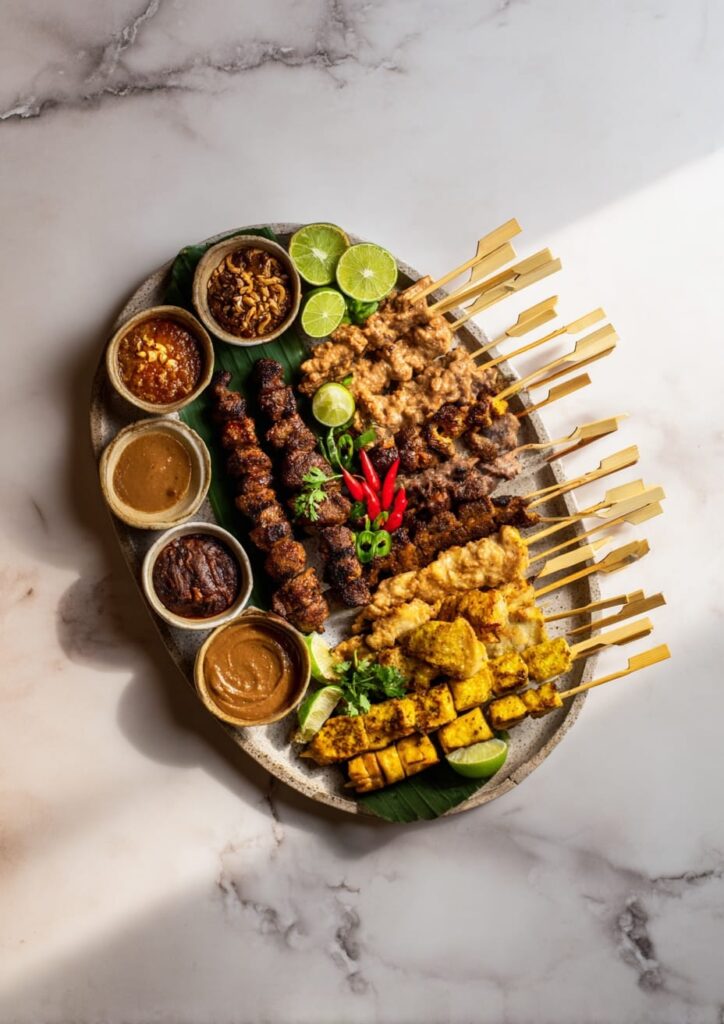
I love setting out bowls of sambal kecap, curried sauce from Sate Padang, and peanut sauce from Sate Ayam so everyone can mix and match. The full guide is in my Indonesian Satay BBQ Platter recipe.
Easy Satay Marinade with Coconut Milk and Palm Sugar
Every good Indonesian satay begins with a good marinade, and this one is my kitchen staple. Coconut milk, tamarind, and palm sugar form the base, balanced with garlic, shallots, and turmeric. It’s creamy, aromatic, and works beautifully with meat, seafood, tofu, or vegetables. I often use it to refresh leftover grilled skewers or to glaze roasted vegetables. You can find the detailed version in my Easy Satay Marinade recipe.
Common Questions About Indonesian Satay
What’s the difference between satay and kebab?
Satay is typically marinated, then grilled and served with sauce, while kebabs often rely on dry spices and are not always served with a dip. Satay also tends to use smaller cuts and a sweeter flavour profile.
Can I make Indonesian satay without a grill?
Yes, a grill pan or oven works well. The key is high heat and basting frequently to mimic the charred edges.
Which meat makes the best satay?
Yes, a grill pan or oven works well. The key is high heat and basting frequently to mimic the charred edges.
Which meat makes the best satay?
Chicken is the most forgiving, but beef and lamb give richer results. Pork is especially good with coconut-based marinades, while fish or tofu work best with lighter, citrusy ones.
What’s the best sauce for satay?
Peanut sauce is the classic choice, but tamarind, soy, and coconut-based sauces are equally traditional in different regions. Try pairing sauces from various recipes for contrast.
Can I make the marinades ahead?
Definitely. Most keep for two to three days in the fridge, and they actually improve as the flavours develop. Just stir well before using.
Are these recipes gluten-free?
They can be. Use tamari-based kecap manis or gluten-free soy sauce to make all ten recipes suitable for gluten-free diets.
Each of these recipes captures a different corner of Indonesian cooking, from the sweet soy of Java to the coconut richness of Bali. What ties them together is the same principle: patience, a hot grill, and flavours that come alive in the simplest way possible. Whether you’re making one skewer or an entire Indonesian BBQ platter, satay has a way of turning any meal into a small celebration of spice, smoke, and care.

